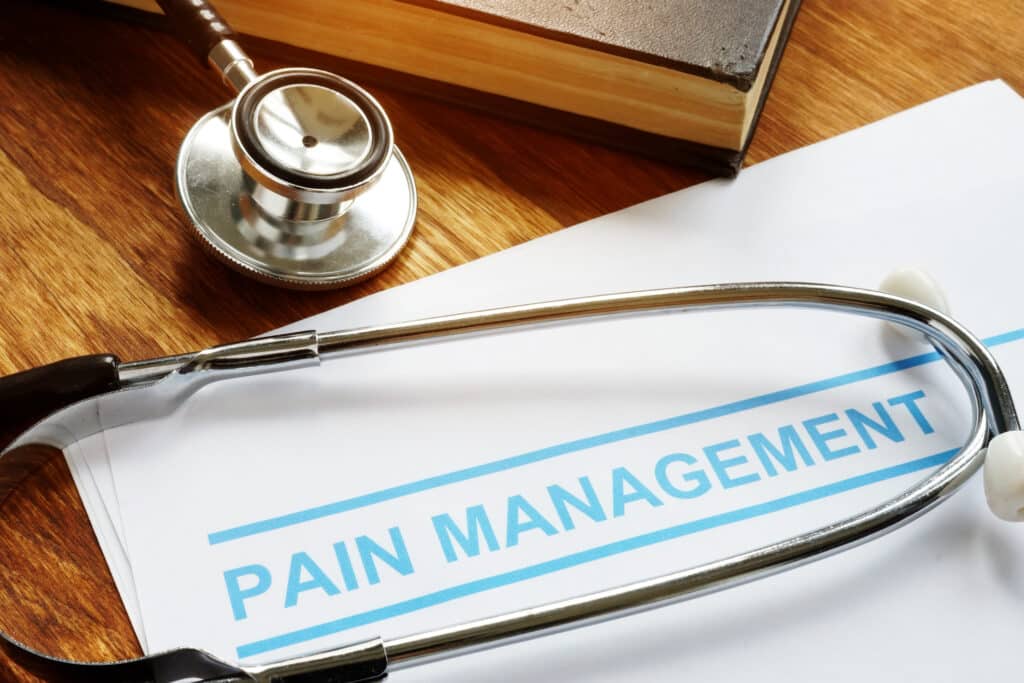Effective pain management is an ongoing challenge for healthcare employees at any institution from the boardroom to the bedside. Pain is a complex process that often requires a holistic and interprofessional approach to treatment. Potential causes, the patient’s underlying condition, and available options are just a few concepts that go into providing therapeutic and compassionate pain management.
Pain broadly falls into two categories: chronic and acute. Each requires nurses and doctors to employ highly specific methodologies and best practices to manage effectively. Not only is it important to alleviate suffering with proper prescribing, but healthcare professionals need to consider factors like addiction, efficacy, and alternative therapies that can work together to support the best possible outcome.
Fortunately, pain management has evolved tremendously over the last decade, and gone are the days of simply trying to prescribe the pain away. Here are some of the important factors all healthcare workers should consider surrounding chronic vs acute pain, and strategies for providing effective care.
Understanding Chronic and Acute Pain
Chronic and acute pain usually arise from extremely different circumstances, and everything from how they manifest to how they’re managed is driven by characteristics unique to each. Understanding the difference between chronic vs. acute pain is the first step toward creating a safe and effective plan of care.
Chronic Pain
Chronic pain is pain that persists for months or years. It can include everything from nagging joint aches to debilitating back issues, and its effects can permanently impact someone’s daily routine and quality of life. Chronic pain is one of the most prevalent conditions experienced by Americans today, with about 50 million adults reporting frequent and ongoing struggles.
The symptoms of chronic pain are often described using words like “aching”, “burning”, or “throbbing”. The root cause is typically related to chronic medical conditions like migraines, osteoporosis, arthritis, or sickle cell anemia, although potential causes are wide-ranging and may be difficult to pinpoint.
Chronic pain is especially significant because it can have profound effects on other body systems. The relentless stress state caused by chronic pain is well known to impact a patient’s mental health, resulting in compounding conditions like anxiety, fatigue, and insomnia. Research tells us that 35-45% of patients with chronic pain also experience depression, making it a potentially life-threatening challenge.
Acute Pain
Acute pain is typically short-lived, with an onset following something like trauma or other serious medical event. Acute pain is our body's way of telling us that something is wrong right now and needs to be an immediate priority. It is often described using words like “sharp”, “stabbing”, or “tearing”, and is often localized to a specific area of the body.
Depending on the severity of the pain, acute situations can cause major health issues like shock, muscle spasms, and disorientation. It can even result in ongoing mental health issues like PTSD and may require counseling and interprofessional support to manage.
Safe and Compassionate Pain Management
The impact of pain on the American people has caught the attention of many organizations focused on improving the health and safety of our communities. The CDC, for example, has elevated the safe and compassionate management of pain to a public health imperative. While every institution’s goal is to reduce pain and suffering, the expectation of how that should be achieved has evolved significantly in recent years.
In light of the opioid epidemic, chronic pain management in particular has been one of the most public and pressing debates. The healthcare community at large has had to take a sober look at the long-term effects of entrenched prescribing habits, ideologies, and the impact they have on the overall health of patients. On the flip side, people with chronic pain may also be stigmatized as “drug seekers” or “frequent flyers”, which can trivialize real trauma and result in biased treatment.
It’s important to remember that pain is not just felt—it’s lived. Pain management has advanced to include multimodal approaches that treat the patient as a whole. While medication still plays an important role, behavioral interventions and integrative therapies have taken pain management to the next level in patient-centered care.
Treating Acute Pain
The management of acute pain is often straightforward. Because causes tend to be obvious, goal-directed therapies are easy to identify and implement. Also, because treatment isn’t expected to go on for long periods of time, the likelihood of addiction and long-term consequences is often low.
However, that doesn’t mean acute pain will simply just go away. Short-term medications being prescribed for short-term pain make sense, but that still doesn’t mean opioids or other controlled substances are the best options. Treatment should always be considered in conjunction with as many aspects of a patient’s overall condition as possible.
Treating Chronic Pain
Chronic pain demands a long-term solution, and the latest evidence has coaxed many providers into thinking outside the box of traditional prescribing practices. While opioids have their place in medicine, the short and long-term effects of opioids on patients are a serious concern.
The transition away from traditional prescribing practices has brought the value of an interprofessional approach to managing chronic pain to the fore. Just as chronic medical conditions call for a team approach that includes a variety of specialties, the management of chronic pain deserves the same.
Medication
The use of medication has value in the management of chronic pain but should include non-opioid medications whenever possible. The reduced risk of developing dependency as well as the physiologic advantages of non-opioid medications can promote a safer plan.
Behavioral Therapy
Behavioral interventions that take the emotional, physiological, and cognitive aspects of a patient’s experience into account can establish a strong foundation for healing. There is no health without mental health.
Integrative Medicine
Acupuncture, massage therapy, range of motion therapy, and spiritual support can be considered when clinically appropriate. Treating the patient as a whole with a patient-centered mindset can have a significant impact on managing pain.
Exploring Chronic vs Acute Pain Management Strategies
Pain management has come a long way and has evolved into a specialty all its own. With a departure from traditional prescribing practices to a more holistic approach, caring for patients in pain has sought a balance of safety and compassion that is redefining the healthcare landscape.
Premiere is dedicated to being a part of the solution, providing high-quality, science-backed continuing education for health professionals engaged in pain management. Courses like This is such a pain in the…Mouth! How to Treat Oral Pain and the Role of Opioids by Grant Hunsicker, DDS General Dentist, Hunsicker Family Dental, and Megan Arbour, PhD, RN, CNM, CNE Associate Professor, Frontier Nursing University, and Mastering Pain: Mindful Behavioral Techniques for Enhancing Quality of Life in Chronic Pain Patients by Jenna Lapointe, Licensed Independent Clinical Social Worker Mental Health Therapist, Betterhelp, and Megan Arbour, PhD, RN, CNM, CNE Associate Professor, Frontier Nursing University, demystify modern pain management strategies and empower healthcare workers with the tools they need to provide excellent and sustainable care.
All coursework created by Premiere is developed by industry-leading experts in support of the latest best practices.





